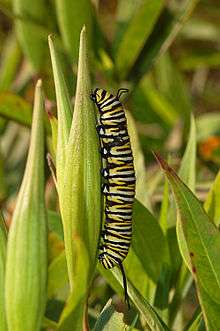Chemical ecology

Chemical ecology examines the role of chemical interactions between living organisms and their environment, as the consequences of those interactions on the ethology and evolution of the organisms involved. It is thus a vast and highly interdisciplinary field.[1] Chemical ecology studies focuses on the biochemistry of ecology and the specific molecules or groups of molecules termed semiochemicals that function as signals to initiate, modulate, or terminate a variety of biological processes such as metabolism. Molecules that serve in such roles typically are readily diffusible organic substances of low molecular mass that derive from secondary metabolic pathways, but also include peptides. Chemical ecological processes mediated by semiochemicals may be intraspecific (occurring within a species) or interspecific (occurring between species).[2]
The field relies on analytical and synthetic chemistry, protein chemistry, genetics, neurobiology, ecology, and evolution.[3]
Plant-insect interaction

The chemical ecology of plant-insect interaction is a significant subfield of chemical ecology.[4][5] In particular, plants and insects are often involved in a chemical evolutionary arms race. As plants develop chemical defenses to herbivory, insects which feed on them evolve immunity to these poisons, and in some cases, re-purpose these poisons for their own chemical defence against predators. One of the more well-known examples of this is the monarch butterfly, the caterpillars of which feed on the milkweed plant. Milkweeds contain cardenolide toxins, but monarch butterfly caterpillars have evolved to remain unaffected by the toxin. Instead, they sequester the toxins during their larval stage and the poison remains in the adult, making it unpalatable to predators. Many other such examples of this exist, including Manduca sexta (hawkmoth) caterpillars which actively sequester nicotine found in the tobacco plant;[4] and the Bella moth, which secrets a quinone-containing froth from its head when disturbed by a potential predator obtained from feeding on Crotalaria species as a caterpillar.
See also
References
- ↑ "What is Chemical Ecology? | CHEMICAL ECOLOGY". NCBS. Retrieved 2017-12-10.
- ↑ Law, JH; Regnier, FE (1971). "Pheromones". Annual Review of Biochemistry. 40: 533–548. doi:10.1146/annurev.bi.40.070171.002533.
- ↑ Meinwald, J.; Eisner, T. (19 March 2008). "Chemical ecology in retrospect and prospect". Proceedings of the National Academy of Sciences. Proceedings of the National Academy of Sciences. 105 (12): 4539–4540. doi:10.1073/pnas.0800649105. ISSN 0027-8424.
- 1 2 Mithfer, Axel; Boland, Wilhelm; Maffei, Massimo E., "Chemical Ecology of Plant–Insect Interactions", Molecular Aspects of Plant Disease Resistance, Wiley-Blackwell, pp. 261–291, doi:10.1002/9781444301441.ch9, ISBN 9781444301441, retrieved 2018-08-21
- ↑ Dyer, Lee A.; Philbin, Casey S.; Ochsenrider, Kaitlin M.; Richards, Lora A.; Massad, Tara J.; Smilanich, Angela M.; Forister, Matthew L.; Parchman, Thomas L.; Galland, Lanie M. (2018-05-25). "Modern approaches to study plant–insect interactions in chemical ecology". Nature Reviews Chemistry. 2 (6): 50–64. doi:10.1038/s41570-018-0009-7. ISSN 2397-3358.
Further reading
- Berenbaum MR & Robinson GE (2003). "Chemical Communication in a Post-Genomic World [Colloquium introductory article]". Proc. Natl. Acad. Sci. U.S.A. 100 (Suppl 2, November 25): 14513. Bibcode:2003PNAS..10014513B. doi:10.1073/pnas.2335883100. PMC 304109.
- Wajnberg, Eric; Colazza, Stefano (2013). Chemical Ecology of Insect Parasitoids. Blackwell. ISBN 978-1118409527.
- Putnam, A. R. (1988). "Allelochemicals from Plants as Herbicides" Weed Technology. 2(4): 510-518.
External links
| Wikimedia Commons has media related to Chemical ecology. |
- A new antibiotic in African ants putatively protective of insect-fungi symbiosis through control of bacterial infections
- Insect Olfaction of Plant Odour
- International Society of Chemical Ecology
- "Search: Chemical ecology reviews". PubMed. U.S. National Library of Medicine.